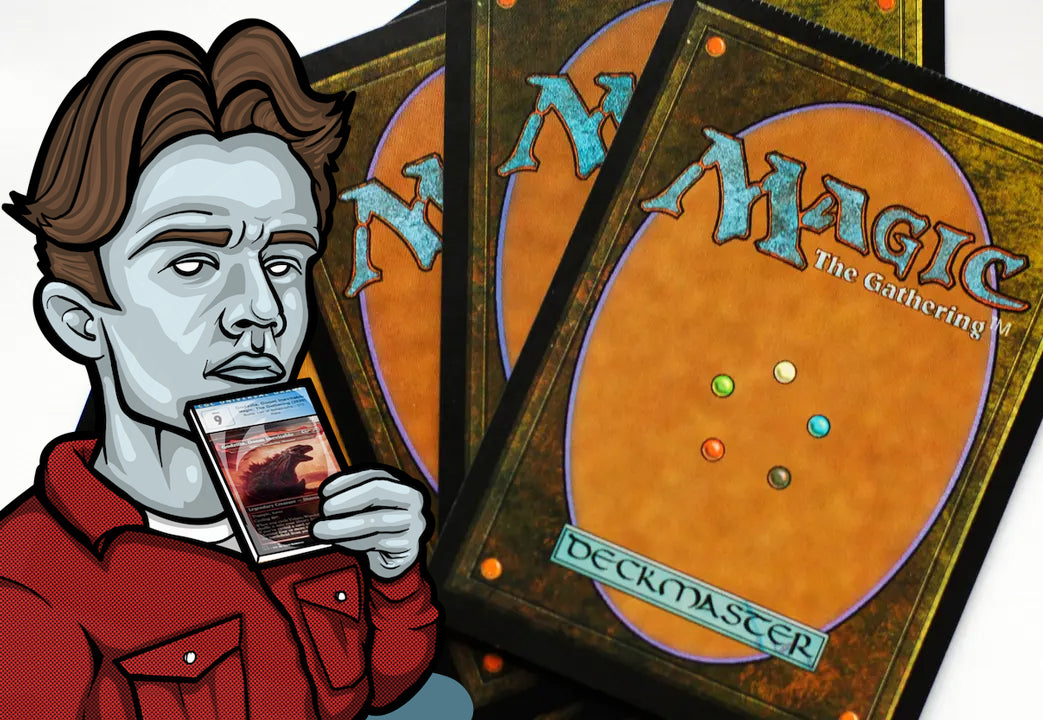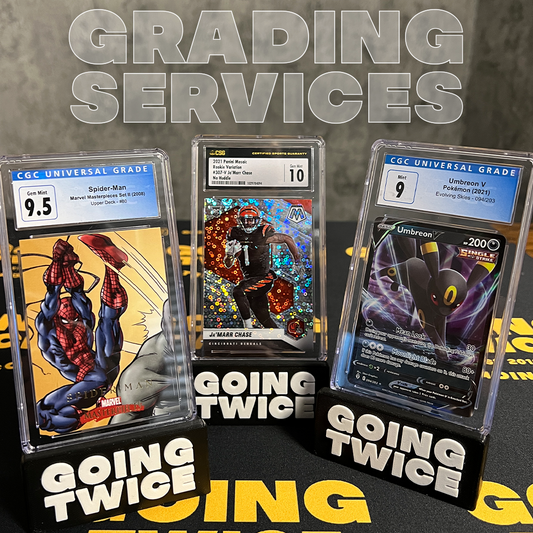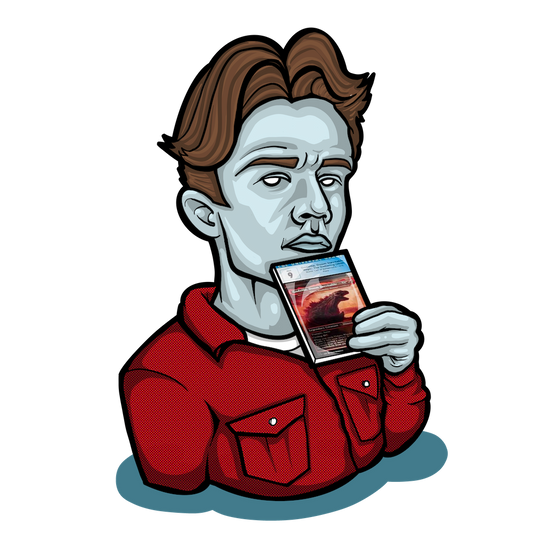We have finally arrived! After weeks of going through the technological innovations that would lead to the collectible card market of the modern day, and one of the largest companies in trading card history: Topps, we have come to the moment in time when tabletop gaming and collectible cards were changed forever. Without Richard Garfield, Wizards of the Coast, and Magic the Gathering, we would not have our precious Pokemon and Yu-gi-oh that came years later.
Humble Beginnings
Magic the Gathering is THE playable trading card game, but Magic wasn’t actually the game Richard Garfield was hoping to make when he first approached the Wizards of the Coast founder, Peter Adkinson. Instead, Richard was interested in getting his game RoboRally published, where the players would compete to move their robots across a board by predetermining their motions. While Peter liked the game, Wizards of the Coast in 1991 consisted of only two people working out of Peter’s basement so the cost associated with publishing RoboRally, the robots in particular, was daunting. Peter asked Richard to instead come up with a more portable game, something that could be easily transported to a gaming convention. And thus, Magic the Gathering was born!
It's Magic!
But not right away. Richard had been working on a card game in the 1980’s he had titled “5 Magics” where the players would have access to completely different abilities based on which alien race their deck consisted of. He had also begun to work on a way to make a game out of collectible baseball cards, something that didn't exist outside of the Topps set in 1952 I briefly mentioned in a previous article. Taking these two ideas and putting them together, Richard came up with a collectible card game that could be played multiple times and be different every time depending on what combinations of cards were in the player’s decks. Needless to say Peter at Wizards of the Coast absolutely LOVED what Richard had come up with and was excited for Richard to keep developing the game, now titled “Manaclash”. The only issue was that Wizards of the Coast was in a current legal battle with Palladium over what Palladium saw as copyright infringement, so Richard continued work on Manaclash under the shell company “Garfield Games” in case Palladium took all of Wizards’ assets, Manaclash included. In 1993, the suit was settled and Garfield Games was dissolved, bringing Manaclash, now with its Magic the Gathering title it would be released under, back to Wizards of the Coast.
The Launch
In July of 1993, Magic the Gathering made its debut at the Origins Game Fair in Dallas, Texas. Players were introduced to the rules and artwork for the first time and the reception was, in a word, enthusiastic. For the first time Richard and Peter got to see how the card game played in a large group of players and the results were fantastic. The game was revolutionary, a word thrown around too often these days to describe reworks of old concepts but in this case, Magic the Gathering truly was a pioneer. From a collecting perspective, the new sets and furthering of lore gave Magic an infinite number of possibilities and endless sets to chase after in the future. This also meant that the game could be constantly updated to keep it fresh, and Wizards of the Coast would be able to make a TON of money if this went well. Word of the new game spread quickly, and in Indianapolis at Gen Con the next month, the entire 2.6 million card initial print run sold out, which had been expected to last them until the end of the year. Peter worked quickly to get more printed, but supply could not meet the demand, and as soon as new Magic packs hit the shelves, they were cleared out in a matter of days. Fearful that the game’s success might be a passing fad, Wizard’s limited the print runs during the games first couple years, hence why those cards can be so expensive in the modern collecting market. Not until Fallen Empires, the fifth expansion set, did Magic the Gathering players not receive the set with open arms due to its lack of many quality playable cards and changes to the rarity system. Unfortunately this was also the first set Wizards decided to really lean into the demand and printed 5 times the amount of cards they had for the previous set, The Dark, and Wizards was stuck holding inventory until 1998.
Pro Circuit
Magic the Gathering still has one of the largest player bases of any trading card game, rivaled only by Yu-gi-oh which similarly inspired more actual play than just collecting alone. Today we have the world championships for every major card game and online versions to go along with in person play. In the 1990’s this level of competitive play simply didn't exist, and not until Magic the Gathering and Wizards of the Coast, was an organized international standard of play set up. The community of players had grown so large and so quickly that populating regulated tournaments was simply a matter of logistics not enthusiasm on the player’s part. However the sets after “The Dark” in 1994 had begun to tank. Starting with Fallen Empires and extending until Homeland (arguably the worse set ever made), sales and player excitement has begun to wane, and in some cases free fall. Shops were stuck with tons of Magic the Gathering product they simply could not sell. On top of that, tournament play had no central organization, and set rules to make a standard of play didn't exist yet. To kill two birds with one stone, Wizards set out to make the first Pro Tour, hosted in New York City in 1996, and invited the best 238 MTG players in the world to come compete for the first Championship. This allowed Wizards to host qualifying tournaments at a local level, introducing the new “standard” format of gameplay with a 15 card side deck and give some structure to competition across the board. It also allowed Wizards to juice excitement in the new set releases by requiring 5 cards from each playable set to be in the player’s decks. The players had to be fluid and adapt to this new structure at the championships in NYC, the first time this rule was put in place and made them think long and hard about sets they otherwise might have ignored. The Pro Tour was a success, and allowed Magic to continue on expanding its player base into the 21st century and reach its 30th birthday this year.
Copycat
With the wild success that Magic the Gathering had, it is not surprising that game makers quickly sought to replicate it. Failed attempts by many franchises, the Simpsons and Sailor Moon for example, marked the mid to late 90’s and companies tried to cash in on the trading card bubble that Magic had kicked off. Pokemon and Yu-gi-oh would end up being the two big success stories as most of the others would fade away into obscurity, though Star Wars did also have some success. Magic proved that building a game that lets a player win by choosing their own strengths and weaknesses and showing their own personality through their gameplay could not only work but become a staple in the gaming community. As I discussed in earlier articles, collecting can be an expression of oneself, a way to help define parts of us that words alone cannot. While I have never collected Magic cards or played the game, I can appreciate that my favorite franchise, Pokemon, may have existed without Garfield’s creation, but the early cards and the gameplay that took the world by storm certainly would not have. Magic the Gathering gave the world its first big trading card game, and would inspire franchises that would go on to define the childhoods of millions of children, some of whom would grow up to be like me, still collecting, still enjoying the hunt and the community.




